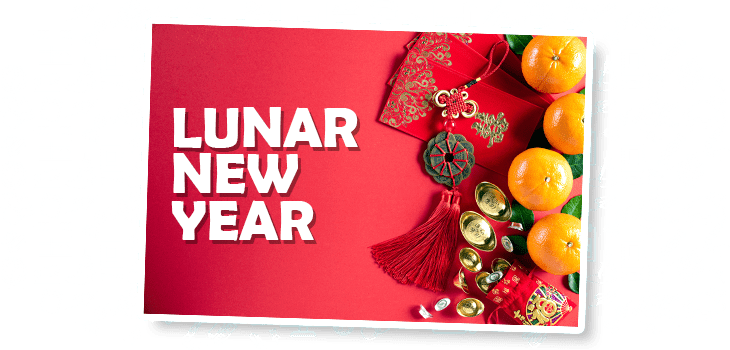The Lunar New Year also known as “Spring Festival” in some areas, is the observance of the new year using the lunisolar calendar. It’s traditionally celebrated in several Asian countries such as China, South Korea, Tibet, and Vietnam, not to mention diaspora communities of Asian descent in the US and all around the world. The new year begins with the first new moon of the lunar calendar and ends 15 days later on the first full moon of the lunar calendar. A lunar year includes 12 full cycles of the moon and is around 354 days.
Interesting Facts About Lunar New Year
The origins of the Lunar New Year are thousands of years old and have evolved as communities of Asian heritage have immigrated to countries all around the world. It’s a time for families to follow traditions that will bring them good fortune throughout the year. Let’s take a closer look at some fun facts.
- An important Lunar New Year legend in Chinese mythology is that of Nian, a terrible beast believed to devour human flesh on New Year’s day. Nian is afraid of loud noises, the color red, and fire. That’s why firecrackers are set off, red colors are used, and lanterns are lit.
- Red is also a symbolic color for good luck and is used in many Lunar New Year decorations and clothing.
- Those who participate in Lunar New Year festivals in China write the character 福 [fú], which means “good luck” on a square of red paper. The paper is then hung in a diamond shape, upside down, to symbolize good luck pouring down on you.
- Some families avoid crying, using scissors, getting haircuts, and wearing black and white at the start of the new year because these behaviors are associated with sadness and cutting off connections.
- To ensure they begin the new year with a clean start, many families prepare for Lunar New Year by paying down their debts, cleaning their homes, and getting new haircuts, a couple days before the start of the new year.
- Red envelopes full of money are traditionally given out from an older person or parent to children, or anyone who’s not married. They are recognized as lì xì in Vietnamese and in Chinese, lai shi in the Cantonese dialect, and hóng bāo in the Mandarin dialect.
- Traditional Lunar New Year foods often include rice as a key ingredient to celebrate the upcoming Spring rice harvests:
- Chinese nian gao, sweet cake symbolizing progress and growth
- Vietnamese bánh chưng/tet, savory rice cake symbolizing gratitude
- Korean tteokguk, a soup with sliced rice cakes representing good fortune, and new beginnings
- Tibetan khapse, a fried cookie often used as shrine offerings
- In the US, the Smithsonian documents the first Lunar New Year celebration in 1851 held by Chinese businessmen for American upper class attendees. In the 1860s then came the first community-driven celebration when Cantonese immigrants in San Francisco infused traditional practices with the uniquely American parade.
- While cities like New York, San Francisco, Los Angeles, Chicago, and Houston may have the largest communities of Asian-Americans, Lunar New Year celebrations happen all across the US.
Incorporating Lunar New Year Into Your Homeschool Plans
When you incorporate Lunar New Year into your homeschooling curriculum, you’re not only having a genuinely good time with your kids, but also providing a unique educational moment that includes skills such as reading, writing, math, art, history, cultural learning, project planning, and life skills. Here are some ideas that will definitely please the whole crowd!
- If you plan on decorating your home, turn it into an art lesson by creating your own ornaments, such as red lanterns, paper fans, and dragons. Create your own chun lian, special New Year’s decorations on red paper squares.
- Take a field trip! Do some research with your student to discover what your local Asian-American community may be doing to celebrate and see how you may be able to join. You can start with Asian grocery stores, clubs or groups at your nearby college or university, or there may even be an Asian-American temple or church.
- Learn about the symbolism that is associated with animals during Lunar New Year. For example, in China, the dragon represents wisdom, strength, benevolence, and good fortune. In Korea, birds such as decorative cranes symbolize longevity, and magpies represent good fortune.
- If you cannot find a local celebration to join, try hosting a celebration meal. Get everyone involved by designing invitations, keeping track of the guest list, and decorating the room. Explore traditional Lunar New Year dishes, generate a budget, and shop for the ingredients. Then follow the directions carefully and prepare them.
- Teach your children life skills by cleaning your home together before the new year. This cleaning is a way to “sweep away” bad luck from the past year and start fresh.
Celebrating Lunar New Year is a fantastic, hands-on way for your family to get involved in your local community and learn about other families’ traditions.
Originally published: January 27, 2022







